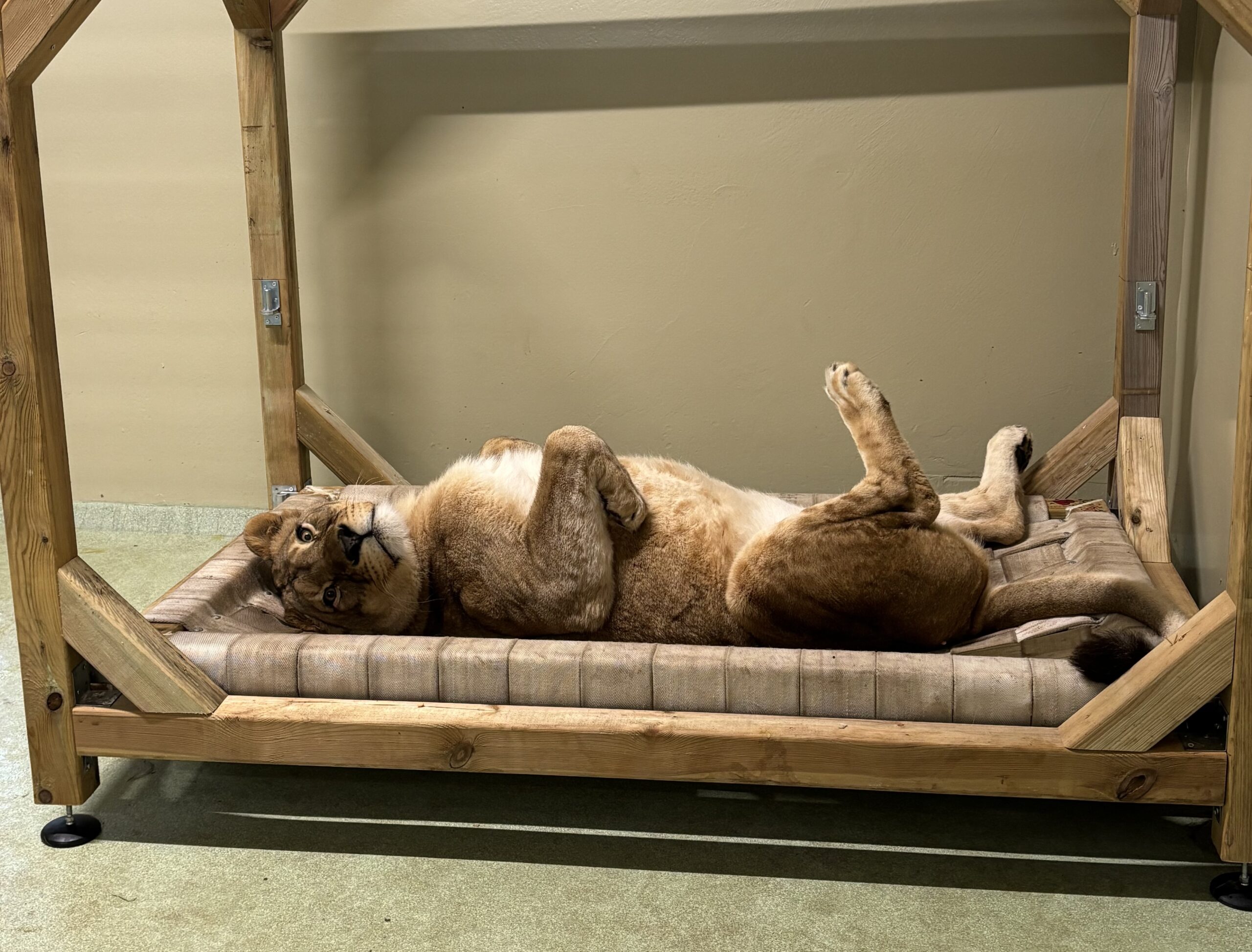Before vs after the move
Putative pheromone effect on behaviors
For Elza (lion) and Simba (lion) the results revealed no significant decrease for the behavior category stereotypic when comparing before and after for the pheromone treatment. This suggests that the putative F3p pheromone has no reducing effect on stereotypic behaviors when animals transition from an old to a new enclosure.
For Elza (lion), a significant increase was found for the stereotypic behavior category when comparing before and after the move for the water control. Furthermore, the stereotypic behavior category showed an overall trend of being performed more often after the move for Elza (lion). For Simba (lion) the observations of the stereotypic behavior category were more or less unchanged between before and after the move. It has previously been reported that animals with a high score on the baseline stress visual analogue scale (VAS) show reduced post-intervention stress when placed in a carrier sprayed with the putative F3 pheromone (Shu & Gu, 2021). This suggests that perhaps the transition from the old to the new enclosure was not stressful enough on the animals for the pheromone to have a significant reducing effect on stress-related behaviors.
There is an alternative explanation for the significant increase of the stereotypic behavior observed in Elza (lion) during the water control. Even though no significant decrease was found during the pheromone treatment, the increased stereotypic behavior during the water control indicates that there may have occurred an overall increase of stereotypic behavior after the move. This suggests that the putative F3p pheromone may have had a small aiding effect during the transition and potentially helped to prevent a spike in the stereotypic behavior as observed during the water control. However, this could also simply be due to the schedule at which the putative pheromone or water was given.

Across both observation phases two out of the four big cats had a significant difference between spray types for the stereotypic behavior category. Manuschka (lion) performed stereotypic behaviors significantly more often during the pheromone treatment and Elza (lion) during the water control. The result of Elza (lion) suggests that the pheromone treatment had a decreasing effect on stereotypic behavior. In contrast, the results regarding Manuschka (lion) suggest that the pheromone treatment had an increasing effect on the stereotypic behavior. Due to the mixed results of the present study, it is important to note that there are mixed results from other studies examining the effect of the putative F3 pheromone on stress-related behaviors. Furthermore, it should be noted that although there was a significant difference between spray types the proportional difference was rather small, which for Elza was 2.07% and Manuschka 3.13%. This indicates that perhaps the effect of the putative pheromone is too small to be sufficient in the future and for other individuals.
Besides the stereotypic behavior category, the behavior categories inactive, active, vocalizations, maintenance, explorative and other, showed a significant difference between spray types for some individuals respectively. Previous studies show varying results, where some studies are consistent with the present study, and some are not.
What happened to the inactive behavior?
Inactive behavior significantly increased during pheromone treatment for Elza (lion) and Manuschka (lion). Similarly, Contreras et al. (2018) found that inactive behaviors increased when domestic cats in a clinical trial were exposed to a putative F3 pheromone diffuser.
What happened to the active behavior?
Active behavior significantly increased during the pheromone treatment for Simba (lion) and during the water control for Elza (lion). The findings by Martínez-Macipe et al. (2015) align with the result for the active behavior category for Simba (lion), but not for Elza (lion). They reported that captive lions (Panthera leo) exposed to putative F3 pheromone gel-diffuser showed an increase in active behaviors such as play, walk and run.
What happened to the explorative behavior?
Explorative behavior significantly increased during the water control for Manuschka (lion) and Elza (lion). In comparison, Martínez-Macipe et al. (2015) found no significant differences between the putative F3 pheromone and placebo for the explorative behaviors such as flehmen, head-rub, investigate and mark.
What happened to the other behavior?
Other behaviors significantly increased during the water control for Tsezar (tiger) and Elza (lion). This is not consistent with that of Martínez-Macipe et al. (2015) who found no significant differences between the putative F3 pheromone and placebo for the other behaviors such as rolling.
What happened to the vocalizations behavior?
Vocalizations behavior significantly increased during the pheromone treatment for Simba (lion). The results from Simba (lion) are consistent with that of Conti et al. (2017) who found that domestic cats exposed to the putative F3 pheromone, at home and in a veterinary hospital, increased stress behaviors such as vocalizations. Moreover, the present study needs to consider the possibility of the increased vocalizations as a result due to Simba’s (lion) health issues resulting in vocalizations as a side effect.
What happened to the maintenance behavior?
Maintenance behavior significantly increased during the water control for Tsezar (tiger), Manuschka (lion) and Simba (lion). This result is not consistent with that of Griffith et al. (2000) who reported a significant increase of maintenance behaviors such as grooming, interest in food and eating, when domestic cats were exposed to feline facial pheromone (FFP), compared to the placebo, when put in a cage.
Very few studies assessed the use and effect of pheromones on wild cats, mainly in reducing stereotypic behaviors. The present study needs to consider that the results shown between species and individuals may be impacted by predisposed stereotypic behaviors, personality traits, individual response to stress and behaviors that cannot be removed or reversed.